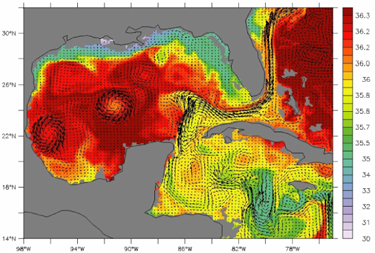|
LOOP Current variability – its relation to meridional overturning circulation and the impact of Mississippi discharge
Principal Investigators: Dirk Nürnberg (IFM-GEOMAR Kiel), Carsten Eden (IFM-GEOMAR Kiel), Sascha Flögel (IFM-GEOMAR Kiel), Joachim Schönfeld (IFM-GEOMAR Kiel), Ralf Tiedemann (AWI Bremerhaven)
Project Scientists: André Bahr (IFM-GEOMAR Kiel), Malte Prieß (IFM-GEOMAR Kiel), Tanja Mildner (IFM-GEOMAR Kiel)
Sea surface salinity in the simulation of the eddy-resolving model FLAME with a 1/12° horizontal resolution, providing a realistic image of the current structure in the Gulf of Mexico.
The Loop Current mediating the oceanic heat and salt flux from the Caribbean Sea into the Atlantic and its interference with the Mississippi discharge are critical for Gulf of Mexico sea surface temperature variability not only affecting regional climate but also driving the water vapor transport towards high northern latitudes.
Within the framework of the Loop project we will focus on two major topics: The first is the impact of the Loop Current extent and variability on the Gulf of Mexico surface hydrography and its change at the beginning and ending of interglacial stages 1 and 5. This includes the reconstruction of the regional extent of the Loop Current and associated hydrographic changes in the Gulf, the assessment of hydrographic gradients between the Gulf and the central Caribbean Sea, and the correlation of local events with continental climate and variations of the thermohaline circulation.
The second major issue is the relation between Mississippi discharge and Loop Current extent. Of particular interest are the temporal and spatial patterns of the freshwater input and its effects on the surface hydrography. Freshwater pulses will be traced within the Gulf and into the North Atlantic, with the aim to study their effect on the large-scale thermohaline circulation.
The methods comprise an interdisciplinary approach including paleoceanographic proxy data (i.e. mainly foraminiferal Mg/Ca and δ18O) as well as numerical modelling using an existing regional eddy-resolving model (FLAME).
Archives
Marine sedimentary records (from the Gulf of Mexico and adjacent Caribbean and western Atlantic areas)
|
| < Prev | Next > |
|---|


